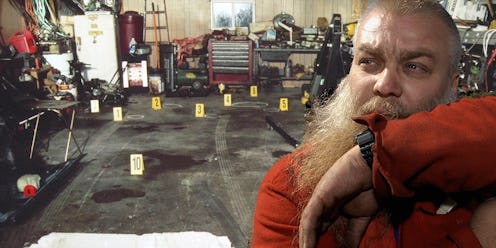
For Steven Avery, the subject of Netflix's investigative Making a Murderer series, the testing of a single vial of blood may hold the key to his future and where he'll spend it. In 2007, Avery was sentenced to prison and convicted for the murder of 25-year-old photographer Teresa Halbach, just four years after being exonerated from 18 years of wrongful imprisonment. But, according to Jerome Buting, his former defense attorney, Avery could be granted a new trial if blood testing methods have evolved since his conviction. Science saved Avery the first time around; now, it could be his last remaining hope.
The vial of Avery's blood, which was drawn in 1996, became a significant piece of evidence 11 years later, when Avery's defense attorneys were certain that they had stumbled upon a breakthrough in the case. Buting expressed his confidence to the Making a Murderer filmmakers when he told them, "This is a red-letter day."
According to Buting, Avery's vial of blood was being held unsecured in the Manitowoc County Clerk of Courts office and appeared to have been tampered with for two reasons. Firstly, the rubber stopper on the vial had been punctured by a needle. Secondly, Buting reported that the evidence tape had been broken. (The Manitowoc County police department denied that they had in any way tampered with evidence.) Avery's attorneys concluded that the blood stains found in Halbach's car were taken from the vial. Their claims that somebody planted Avery's DNA evidence at the crime scene ultimately fell short at trial.
Though the moment was framed by Making a Murderer as an immense sign of hope for Avery's case, the court quickly turned down the tampered vial theory. On Milwaukee writer Jessica McBride interviewed Dennis Ernst, director of the Center for Phlebotomy Education in Indiana. He claimed that piercing the rubber stopper falls in line with industry standards and shouldn't play a role in the defense's case:
How can that happen when there are plenty of experts to testify to that? Piercing the stopper of the tube is the recommended and the only way those tubes should be filled.
Buting maintains the possibility that Avery's blood evidence was planted, but has taken a new angle in his approach to the situation. Shifting the focus towards the ability of the crime labs to detect of an artificial preservative added to drawn blood, Buting may have elicited a new trial for Avery. According to USA Today Network-Wisconsin writers Duke Behnke and Alison Dirr, who scored a landmark interview with Buting, the FBI and the State Crime Lab were the only two parties involved in analyzing the DNA evidence that sent Avery to prison in 2007:
It had never been validated by any other outside lab. To my knowledge it still never has been.
It was impossible for the defense to have the analysis validated because, at the time, no other labs were capable of conducting the tests. The accuracy of the test in question is based on its ability to detect a preservative abbreviated EDTA. If the sensitivity of the test has improved since 2007, the evolution will likely entail a retrial.
"That would be a complete game changer," said Buting. "You certainly don't want to use up whatever sample is left if the science hasn't developed enough and yet maybe could be sometime in the future."
EDTA is an anticoagulant that is added to vials of blood to aid in their preservation. According to the FBI in 2007, the blood spots in Halbach's car were absent of EDTA, suggesting they could not have come from the vial. However, Buting has pointed out that it's possible the EDTA levels were simply too low to be detected by the now outdated analysis. Lab auditor Janine Arvizu, who believed the presence of EDTA wasn't sufficiently ruled out, supported this claim during Avery's trial when she stood as a defense witness.
Even today, EDTA detection isn't common practice and not many labs outside of universities conduct the tests, according to Kelly L. Wouters, the laboratory director at Armstrong Forensic Laboratory in Arlington, Texas:
We don't do EDTA testing but we've been asked about it in the past. We couldn't find a good method for doing it and what methods there are we don't have the equipment for.
If Buting and Avery's defense attorneys plan to re-conduct an EDTA detection test, they'll have to seek out a third-party lab capable of that technology. USA Today reached out to the FBI to ask whether or not improvements have been made in EDTA testing, but the bureau refused to comment. Thus, some important questions remain before the case can be brought back to court. Avery's defense attorneys must determine the status of EDTA testing, find out if its detection method has improved significantly, and seek out a technician who can conduct the test as a third party.
Images: Netflix (3)